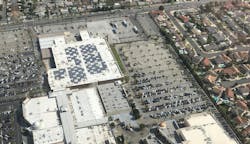Thinking outside the big box (store)
For over a decade now, the talk of the mall industry has been largely focused on what developers can do to fill the voids left by a steady number of big box store closures. The solutions have been as elegant as to reposition the empty boxes to offices, and as creative as indoor go cart tracks. Unfortunately, while the industry has been occupied by this problem, another issue that’s perhaps just as thorny has gone largely unaddressed: What to do when big box tenants stay put?
Big box tenants often have Reciprocal Easement Agreements (REA) that lock them in place for decades and can create a myriad of problems when it comes time for repositioning. Often these agreements leave the developer powerless to do anything with the big box space, no matter how dated the façade or potholed the parking field. In a best-case scenario this can force designers and developers to work around the big box tenant, which if not handled carefully can create planning issues and a patchwork design aesthetic. At worst, developers may decide a patchwork repositioning isn’t worth the hassle and to put off a much-needed refresh for an aging mall.
Fortunately, there are strategies that designers and developers can use to work around the limitations caused by REA’s. Creative design and planning around the tenant, cooperation with the tenant, and negotiating a buy out of the tenant are all viable options available to developers to execute a worthwhile and effective repositioning.
Creative Design and Planning for Big Box Stores
Although every mall is unique in its repositioning needs, and each REA enforces its own restrictions on developers, creative planning and design can often make the best of a tough situation by reinventing the relationship between the big box tenants and the rest of the mall to create new synergies.
One way this can be done is to create new or easier access to the big box tenant. For instance, building a new parking structure in a big box’s surface lot can make more effective use of the land. It can also create a second level access where there previously wasn’t one, offering shoppers a new path of travel through the shopping center drawing them to the big box tenant. Similarly, creating a second entrance from the parking field, not only gives shoppers a refreshed visual link that draws them to the big box tenant but can also create an opportunity to unify the exterior design of the mall.
Cooperation
In some instances, developers can work with the tenant to work out a mutually advantageous solution. Relocation and/or redesign are often a best-case win-win for both tenant and developer. Relocation can offer the tenant a new location that makes more sense for their business model. For the developer, relocation offers an opportunity to enhance the function of the property, while feeding into the energy of the redesign.
Whether or not they choose to relocate, a repositioning can present and excellent opportunity for tenants to modernize their aesthetic and rethink their merchandising in a way that feeds into the flow of the repositioning, making a more attractive environment for the shopper and a more seamless repositioning. For example, if the design of the repositioning prominently features glazing, the tenant may rethink their merchandising to create attractive window displays to draw shoppers.
Negotiation
A third option available to developers is to simply offer existing big box tenants a buyout. While this option was once unthinkable, with the aforementioned wave of closure over recent years, big box tenants are more amenable to these buyouts than ever.
Additionally, while this option may be the most expensive, it also offers the most freedom to a developer and designer giving them the flexibility to do what they want with the space, rather than having to work with or around the tenant.
While big box tenant REA’s can pose significant challenges for developers and designers aiming to reposition aging malls, these hurdles are not insurmountable. Through creative planning, improved access, and collaboration with tenants, it is possible to breathe new life into the space while preserving the value of the big box stores. In cases where collaboration is not viable, developers may even consider buying out tenants to unlock the full potential of the property. By employing these strategies, developers can create cohesive, modernized shopping environments that better serve both retailers and consumers, alike, ensuring the mall remains a vibrant destination for years to come.
